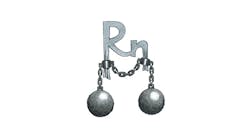You don’t smoke.
You’ve never smoked.
Yet the doctor calls with a diagnosis: lung cancer.
Each year, 21,000 people die from lung cancer caused by exposure to radon - second only to smoking.
This naturally occurring gas is invisible, odorless and tasteless – a silent killer.
“The radioactive gas is released in rock, soil, and water and can build up to create dangerous levels inside homes and work places,” writes Jordy Byrd of labeling supplier Graphic Products.
According to the EPA, which dubs January "Radon Action Month," radon gets in through:
- Cracks in solid floors
- Construction joints
- Cracks in walls
- Gaps in suspended floors
- Gaps around service pipes
- Cavities inside walls
- The water supply
Radon levels above 4 pCi/L (picocuries per liter of air) should be addressed by a professional. To determine the level of radon, yuo can use a home test kit.
"Basic prevention includes sealing cracks and other openings in building foundations or covering sump pump holes in water basins. Aggressive HVAC systems, sub-slab, drain tile, and block wall suction methods are also used, but not proven to consistently lower radon levels in buildings," Byrd writes.
“There’s a huge stigma associated with lung cancer because the majority of people who die from it are either smokers or former smokers,” said Cleveland Clinic oncologist Nathan Pennell. “But the fact is that anyone who has lungs can be exposed to toxins and develop lung cancer, so this is a disease that should concern everyone.”
For more information about radon and safety, visit EPA's National Radon Action Month site.
